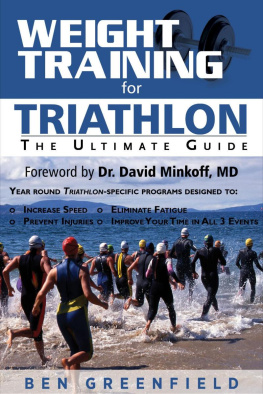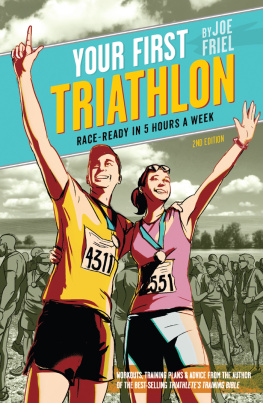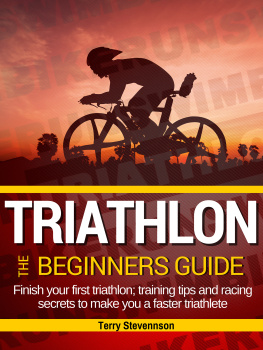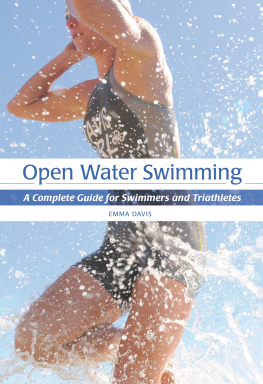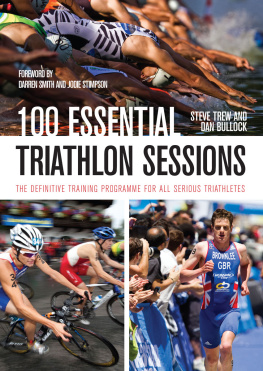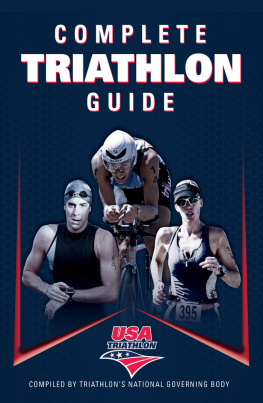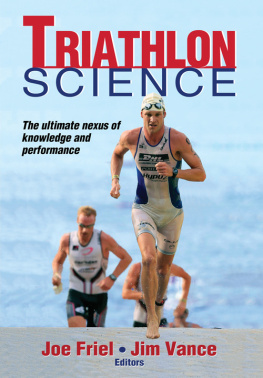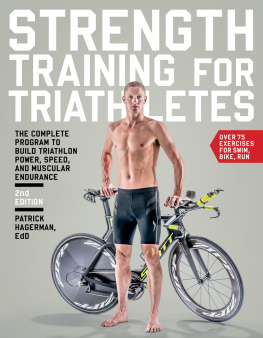INTRO
Id love to do triathlon, but Idnever be able to do the swim.
I just need to get through the swim and get to my bike.Then, Ill be fine.
When I took up triathlon, I thought if I could learn toswim, I could do this sport. Twenty years later, Im still thinking if I couldlearn to swim, I could do this sport.
Those comments (or others just like them) have been said bycountless triathletes who didnt swim much as kids. In my experience, only oneof every 20 (or heck, every 50) triathletes has a solid swim background. Yet,we find ourselves competing in a sport that starts with an organized mosh pitin the water for upwards of 2.4 miles surrounded by a couple thousand of ourclosest friends.
If any of the above sounds like something youve said toyourself, I want this book to bring you hope. Of all three disciplines intriathlon, swimming might be the easiest in which to make improvements. Whilecycling improvement takes an enormous amount of time in the saddle and runningis very dependent on our natural biomechanics and susceptibility to injury,triathletes can easily become top-10-percent-of-the-field swimmers with justthree one-hour swims per week. So, why do triathletes continue to struggle inthe water? There are a number of reasons.
Water is such a foreign environment that were allessentially newborns in Speedos; we have to learn how to swim the same way welearned to walk. Our parents didnt just stand us up and say, Figure it out,kid. They allowed us to learn the skills we would need: first sitting up, thenbecoming aware of our legs, pulling ourselves up on furniture, and walking withhelp, before eventually walking on our own. So, in the same vein, we cantexpect to jump in the water and do a great swim workout without learning properswim technique from the start.
Im going to introduce you to a typical age-group triathletewho might sound familiar. This athlete is taking up triathlon in hismid-thirties. He wants to get healthier and figures triathlon would be a coolbucket-list thing to do. He has played some competitive sports in the past buthe let himself get out of shape while working his office job. Other thangetting through dont drown levels 16 as a kid, he doesnt have much of a swimbackground. He tries to swim two or three times a week and hes determined tofigure out the triathlon swim.
When this athlete swam for the very first time afterdeciding to tackle his first triathlon, he jumped into the pool thinking, Iswam a little when I was a kid. Lets just dust off the cobwebs. Over thefollowing hour, he only managed to swim 14 total laps (350 yards) and he had tostop in the middle of the pool a dozen times. He needed breaks after everysingle lap, he choked on the water, and he lost his breath constantly. When hefinally got to work after swimming, he was blowing chlorine out of his nose forhours.
Does this bring back traumatic memories from when you firstgot back in the pool? If so, youre not alone! This is a rite of passage almostevery adult triathlete goes through.
Swimming is one of the most unnatural movements humans couldpossibly do. We evolved to walk around all day long, breathing oxygen. We useour eyes to see where were going, we hold ourselves upright, and we moveforward with our legs. Swimming, on the other hand, happens under water with nooxygen. We cant really see where were going (and sometimes we cant even seeour hands in front of our faces in open water), were in a horizontal proneposition, and we have to create most of our forward movement with our armsinstead of our legs.
See? Its among the most unnatural things a human could do!And dont even get me started about the deep-water sea monsters Im stillconvinced are just waiting for the right race to take me out.
Lets go back to that typical age-group triathlete from afew paragraphs ago. After a couple years of struggling to swim on his own, hedecided to take triathlon seriously so he joined a masters swim group andstarted getting occasional one-on-one swim instruction from a local coach.Great idea, right? Not so fast.
Lets think about how that person became a swim coach. Moreoften than not, coaches become coaches because they were elite swimmersthemselves in the past but usually not triathlon swimmers. Because of that,they coach triathlon swimmers the same way they were coached as young swimmersthemselves. Unfortunately, this lack of knowledge of the specifics of triathlonswimming can lead to well-meaning but inappropriate instruction.
When elite swimmers grow up training for speed, theygenerally have genetically gifted bodies and training schedules that weage-group triathletes can only dream of. For example:
Elite swimmers have the body flexibility of Gumby. We age-grouptriathletes typically have a lifetime of desk work in our now-stiff upper bodiesand a load of running in our legs which decreases our ankle flexibility. Wesimply cant move the same way elite swimmers do.
Elite swimmers often train for events where 90 percent of theirraces last three minutes or less; the swim portion of triathlons are anywherefrom 10 minutes to two hours. Do you think our swims might require a differentmethod of training?
Elite swimmers get to empty the tank in their swim race, hang outon the pool wall for a minute or two, and then go sit in a hot tub for half anhour. Meanwhile, triathletes swim like crazy for a long distance in open waterthen proceed to cycle and run for up to 15 more hours.
Elite swimmers have only one sport to train for so they can trainmore than 10 times a week, amassing up to seventy thousand yards. Do any of youhave time for that?
Elite swimmers train and race in perfect, controlled conditions.Pools have big lane ropes to knock down any waves, a nice black line on thebottom of the pool to follow, flags overhead to tell swimmers how far the wallis, and gutters to make the pool as calm as possible. Contrast that with theblind chaos we endure in the open water (not to mention the unpredictableconditions) and you almost start envying those elite swimmers.
Do you see how not all swimming is the same? So, whathappens when former elite/speed swimmers teach age-group triathletes how toswim? The coaches often try to fit a square peg into a round hole. Theyinstruct age-group triathletes to do things only elite swimmers are typically capableof. In many cases, this does more harm than good.
Take kicking, the bane of most age-group triathletesexistence. Elite swimmers cover tens of thousands of yards each week, workingon their kick, usually with their hands clasped on the front of a kickboard andtheir heads out of the water. This approach causes a problem for age-grouptriathletes. First, we dont have enough back flexibility or body awareness tostick our heads out of the water while still keeping our feet at the surface ofthe water. As such, traditional kick drills actually encourage age-groupswimmers to drop their legs in the waterif the head goes up, the legs go downlike a seesaw in the water. This exacerbates one of the top problems age-grouptriathletes have: sinking legs.
Beyond making the sinking legs worse, traditional mindlessmeters of kicking dont have a big return on investment for triathletes. Evenelite swimmers only get a maximum of 10-15 percent of their forward propulsionfrom kicking we age-groupswimmers only get between 0 and 5 percent. (In fact, some even have negative propulsion. Have you ever seen someone who kicked andmoved backward? Its a thing!) So even if we did improve our kick by double, itmight only amount to a slight improvement in total propulsion.


